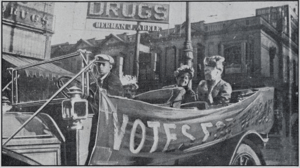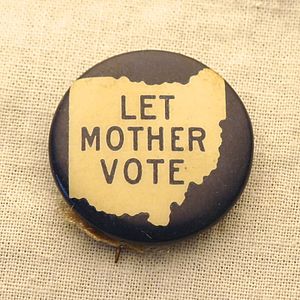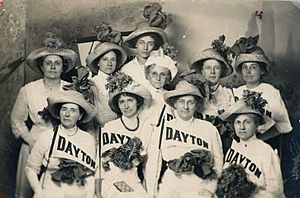Timeline of women's suffrage in Ohio facts for kids

This is a timeline showing how women in Ohio fought for the right to vote. This movement, called women's suffrage, really started in Ohio around the 1850s. During this time, many important meetings about women's rights happened across the state.
One very important meeting was the Ohio Women's Convention in 1850. Another big event was the second Ohio Women's Convention in Akron, Ohio. At this meeting, Sojourner Truth gave her famous speech, Ain't I a Woman? Women worked hard to create groups and organizations. These groups tried to convince politicians to support women's right to vote.
Even though several attempts to change the state constitution failed, women in Ohio did gain some voting rights. They could vote in school board elections and in some local city elections. Ohio was the fifth state to officially approve the Nineteenth Amendment. This amendment finally gave women across the United States the right to vote.
How Women Gained the Right to Vote in Ohio
Early Efforts in the 1800s
1802
- November: The Ohio Constitutional Convention decides that only white men can vote in the state. Ohio becomes the second state to limit voting based on race in its constitution.
Important Meetings in the 1850s
1850
- April: The first women's rights meeting held outside of New York takes place in Salem, Ohio. About 500 people attend the Ohio Women's Convention.
- May 6: A state meeting is held in Columbus to discuss the Ohio Constitution. A suggestion to remove the words "white" and "male" from the voter description fails by a lot of votes.
1851
- The Ohio Women's Convention in Akron, Ohio features Sojourner Truth as a speaker. She talks about equality for African-American women.
1852
- The Ohio Women's Convention in Massillon, Ohio creates the Ohio Women's Rights Association (OWRA).
1853
- October 5: The National Women's Rights Convention is held in Cleveland.
- May 25: The first meeting of the Ohio Women's Rights Association (OWRA) happens in Ravenna, Ohio.
1854
- Caroline Severance, who leads the Ohio Women's Rights Association (OWRA), reads a petition for women's rights to the Ohio Senate.
1855
- October 18: The National Women's Rights Convention is held in Cincinnati.
Organizing for Suffrage in the 1860s
1867
- Famous suffrage leaders like Susan B. Anthony, Elizabeth Cady Stanton, Lucy Stone, and George Francis Train start campaigning for women's suffrage in Ohio, beginning in Cleveland.
1869
- The American Woman Suffrage Association (AWSA) is formed in Cleveland.
- November 24–25: AWSA holds its first big meeting in Cleveland.
- The Toledo Women's Suffrage Association (TWSA) is created.
- The Dayton Woman's Suffrage Association (DWSA) is also formed.
Progress and Setbacks in the 1870s and 1880s
1871
- The Dayton Woman's Suffrage Association (DWSA) closes down.
1873
- A petition asking for women's suffrage is presented at the Ohio Constitutional Convention. Ideas for women's suffrage fail at this meeting.
1874
- The Women's Christian Temperance Union (WCTU) is started in Cleveland.
1876
- The Toledo Woman Suffrage Association (TWSA) refuses to join a Fourth of July celebration. They state it's "inconsistent as a disfranchised class" to celebrate liberty that only half the people have.
1880
- Susan B. Anthony attends the Democratic National Convention in Cincinnati.
1884
- A small suffrage meeting takes place in Columbus.
1885
- The Ohio Woman Suffrage Association (OWSA) is founded in Painesville, Ohio.
1888
- Louisa Southworth of Cleveland begins collecting names of Ohioans who support women's suffrage. She wants to show that many women actually want to vote.
- Two ideas for full and local women's suffrage are introduced in the Ohio Legislature, but both fail.
1889
- Another bill for full suffrage is introduced in the Ohio Senate. It does not get the needed three-fifths majority to pass.
Gaining School Board Voting Rights in the 1890s
1891
- Suffragists ask the Ohio Legislature for action, but no bills for women's suffrage are introduced.
1892
- A bill to allow women to vote in school board elections is introduced in the Ohio House. It does not pass.
1893
- Another bill for school board suffrage is introduced, but it also does not pass.
1894
- January: A school board suffrage bill is introduced again in the House and is narrowly defeated.
- April 10: A similar school board suffrage bill is introduced in the Ohio Senate and passes easily.
- April 24: The Senate bill goes to the House, where it passes.
- A new law in Ohio allows women to vote in school board elections. Women can also run for office on the school board.
- December: Ida M. Earnhart in Columbus is one of the first women to sign up to vote in the next school election.
1895
- January: A lawsuit is filed against Earnhart and the election board to remove her name from the voter list. The case is heard in the Franklin County Circuit Court.
- February 1: The Franklin County Circuit Court declares that the law allowing women to vote in school board elections is legal.
- Women vote in their first school board elections.
1896
- Henrietta G. Moore of Springfield, Ohio and Laura A. Gregg from Kansas travel around Ohio for OWSA. They help set up more local suffrage groups.
1897
- A suffrage meeting is held in the Fall in Toledo.
1898
- February 10: An attempt to cancel school board suffrage in the Ohio House is defeated.
- April: The National Woman Suffrage Conference is held in Cincinnati.
- May: The fifth annual Ohio Women Suffrage Convention takes place in Akron. Speakers include Susan B. Anthony, Anna Howard Shaw, and Zerelda G. Wallace.
1899
- Harriet Taylor Upton becomes the president of OWSA.
The 20th Century and the Right to Vote
Early 1900s Efforts
1900
- Harriet Taylor Upton visits "fifteen main towns" in Ohio to help start organized suffrage groups. By the end of the year, she had doubled the number of people involved in suffrage efforts.
- January: The Ohio Legislature considers a bill for equal voting rights.
1903
- The National American Woman Suffrage Association (NAWSA) moves its main office to Warren, Ohio.
The Push for Full Suffrage in the 1910s
1910
- NAWSA's main office moves from Warren.
1911
- June: Elizabeth Hauser organizes a suffrage rally at Cedar Point. Speakers include Harriet Taylor Upton and Newton D. Baker.
- October: The Ohio Women's Suffrage Association (OWSA) holds its yearly meeting in Dayton. Anna Howard Shaw is a special speaker.
1912
- January 18: Dora Bachman of Cincinnati presents a women's suffrage amendment idea to the Ohio Constitutional Convention's committee.
- A vote on a women's suffrage amendment to the Ohio Constitution is placed on the ballot.
- August 27: OWSA organizes a suffrage parade in Columbus. About 5,000 women participate in the parade.
- September 3: The 1912 Ohio suffrage amendment does not pass.
- A law is passed in Ohio allowing individual cities to decide if they want to grant women the right to vote within their city.
- A larger group, the Franklin County Women's Suffrage Association (FCWSA), is formed.
- The Woman's Suffrage Party of Montgomery County is formed.
- The Lima Federation of Women's Clubs invites Emmeline Pankhurst to speak in Lima, Ohio.
- Cornelia Cassady Davis wins a prize for the "best suffrage poster" from OWSA for her "Let Ohio Women Vote" image.
- The Shelby Equal Franchise Association is formed in Shelby, Ohio. It is part of the local WCTU.
1914
- January: The Socialist Party and Progressive Party in Ohio announce their support for women's suffrage.
- May 9: Preachers who are part of the Ministerial Association of Columbus speak on Mother's Day. They say that giving women the vote would help them "better fulfill their maternal duties."
- October: Carrie Chapman Catt and Harriet Taylor Upton come to speak in Lima, Ohio. A parade is held that draws more than 1,500 people supporting women's suffrage.
- October: Suffragists in Cleveland hold a parade. More than 10,000 women and 400 men march and ride on horseback.
- November 3: The second Ohio women's suffrage amendment is rejected.
1915
- The Ohio Woman Suffrage Association (OWSA) invites NAWSA and the Congressional Union (CU) to set up offices in Ohio.
1916
- June 6: The Municipal Suffrage Amendment in East Cleveland passes. This allows women to vote in city elections.
1917
- February: A representative from Cuyahoga County introduces a bill in the Ohio legislature. This bill would allow women to vote in presidential elections.
- February 21: Governor James M. Cox signs the "Reynolds Bill." This bill gives women the right to vote in presidential elections.
- Lakewood, Ohio passes local voting measures for women.
- Challenges to local suffrage are rejected by the Ohio Supreme Court.
- November 6: A public vote rejects the "Reynolds Bill."
1919
- June 16: Ohio officially approves the Nineteenth Amendment. It is the fifth state to do so.
- The Colored Women's Republican Club changes its name to the Colored Women's Independent Political League.
After the 19th Amendment in the 1920s
1920
- April 23: The case Hawke v. the Secretary of the State of Ohio is decided. It states that a federal amendment to the U.S. Constitution does not need to be decided by a direct public vote. This helps solve a problem Tennessee had with approving the 19th Amendment.
- April: The Cuyahoga County Woman's Suffrage Party closes down and becomes the League of Women Voters of Cleveland.
- September: The Political Equality Club of Lima closes and creates the Lima League of Women Voters.
1923
- A public vote passes to remove the phrase "white male" from the description of a voter in the Ohio Constitution.





